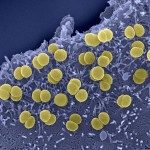Link to Pubmed [PMID] – 24695776
Clin. Vaccine Immunol. 2014 Jun;21(6):847-53
New vaccines targeting meningococci expressing serogroup B polysaccharide have been developed, with some being licensed in Europe. Coverage depends on the distribution of disease-associated genotypes, which may vary by age. It is well established that a small number of hyperinvasive lineages account for most disease, and these lineages are associated with particular antigens, including vaccine candidates. A collection of 4,048 representative meningococcal disease isolates from 18 European countries, collected over a 3-year period, were characterized by multilocus sequence typing (MLST). Age data were available for 3,147 isolates. The proportions of hyperinvasive lineages, identified as particular clonal complexes (ccs) by MLST, differed among age groups. Subjects <1 year of age experienced lower risk of sequence type 11 (ST-11) cc, ST-32 cc, and ST-269 cc disease and higher risk of disease due to unassigned STs, 1- to 4-year-olds experienced lower risk of ST-11 cc and ST-32 cc disease, 5- to 14-year-olds were less likely to experience ST-11 cc and ST-269 cc disease, and ≥25-year-olds were more likely to experience disease due to less common ccs and unassigned STs. Younger and older subjects were vulnerable to a more diverse set of genotypes, indicating the more clonal nature of genotypes affecting adolescents and young adults. Knowledge of temporal and spatial diversity and the dynamics of meningococcal populations is essential for disease control by vaccines, as coverage is lineage specific. The nonrandom age distribution of hyperinvasive lineages has consequences for the design and implementation of vaccines, as different variants, or perhaps targets, may be required for different age groups.

